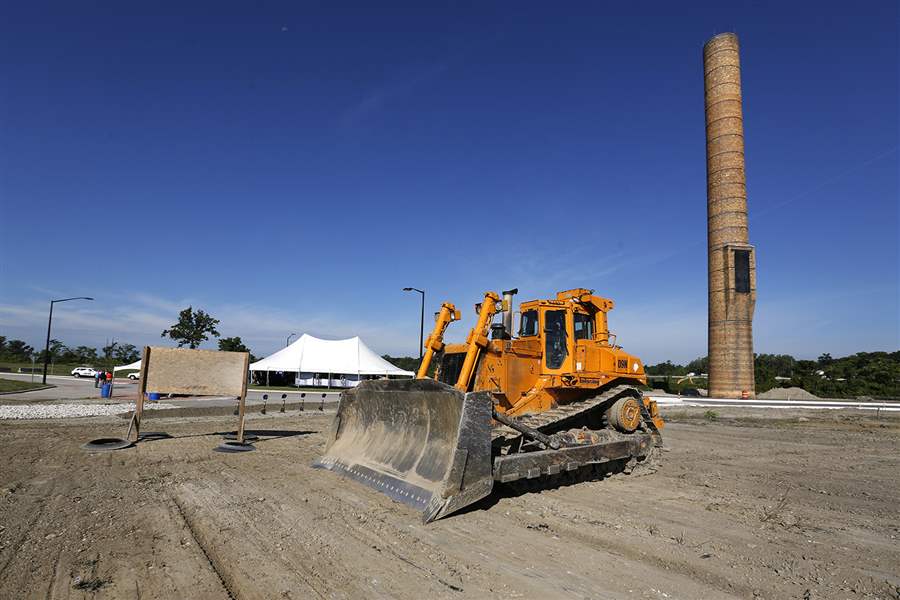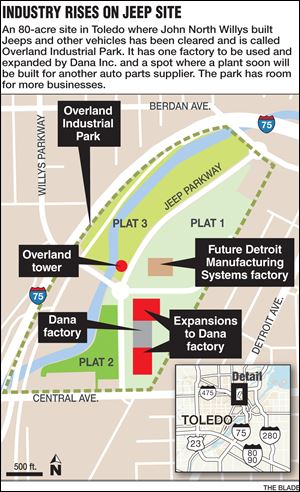
Risk with Overland park paying off
Officials see success with work to bring companies, jobs to Toledo area
8/28/2016
A bulldozer is ready to work on location for the future 100,000-foot structure for automotive parts supplier Detroit Manufacturing Systems, which has signed a seven-year lease for the site at Overland Industrial Park in Toledo.
THE BLADE/ANDY MORRISON
Buy This Image
James Tuschman invoked Kevin Costner last week as he talked about the fledgling Overland Industrial Park in Toledo.
“Do you all remember the movie Field of Dreams? ‘Build it and they will come,’ ” asked the chairman of the Toledo-Lucas County Port Authority. “We did. They’re here.”

A bulldozer is ready to work on location for the future 100,000-foot structure for automotive parts supplier Detroit Manufacturing Systems, which has signed a seven-year lease for the site at Overland Industrial Park in Toledo.
Since the old Jeep Parkway plant was razed nearly a decade ago, the sprawling site has held the potential for an industrial rebirth. Now, after a lot of money, a lot of work — and, indeed, a lot of doubt — the jobs are returning.
In the last three months, two major automotive parts suppliers have announced plans to locate new factories at Overland, lured in part by a multi-million dollar building the port and a local developer put up purely on speculation.
That risk — if we build it, will they really come? — has paid off.
“We’ve got a laundry list of people who are very interested in this site and I’m optimistic, as our directors are as well, that we’re going to fill this site up sooner rather than later and validate the position we took quite a few years ago,” Mr. Tuschman said.
Together, Dana Inc. and Detroit Manufacturing Systems have committed to creating a minimum of 440 jobs. However, officials have said that number could grow to 600. By the time development of the whole 80-acre industrial park is finished, there could be 1,000 or more working at the site.
When the port authority bought Jeep Parkway site for $95,000 in 2010, it didn’t entirely know what it was getting into. Though Fiat Chrysler had razed much of the old factory, there were still tons of old concrete foundations that needed to be removed. Officials also didn’t really know how contaminated the site might be.
After all, automobiles had been built at the site for nearly 100 years. It was where John North Willys launched his Willys-Overland company and where Jeep was born in 1941. The plant would go on to build Jeeps for another six decades and employ generations of Toledoans. When the plant closed in 2006, some 11 million vehicles had rolled off its assembly line.
But all of that work led to some questions about what might be hidden in the soil. Beyond that, the port was taking on a major project at a time when few others were doing anything at all. Toledo was still reeling from a deep recession.
“There was certainly serious and deep discussions about all of this, but I think at the end it was a unanimous decision,” Mr. Tuschman said. “Look, that’s what the port authority is all about. We’re here to foster economic development.”
In the end, environmental contamination was limited. The port spent $10.5 million to prepare the site for redevelopment, with $9 million of that coming from state and federal grants. The rest came from the port’s own coffers. Including infrastructure work in and around the site, the total all-in cost of Overland has been about $70 million, officials said. Roadway improvements made up a significant part of that.
Reflecting on the project last week, port officials said the key to Overland’s success was to put up an industrial building.
“The biggest decision for the board wasn’t taking this on, because we had a lot of partners. The biggest decision for the board was actually building a spec building,” said Bill Carroll, a longtime board member and then-chairman. “We’d never done that before. But we had to prime the pump.”

The port worked with Toledo developer Ed Harmon in a 50-50 partnership to build a 100,000-square-foot industrial building in hopes that the space would help raise the profile and attractiveness of the site. The port covered financing of the $7 million project.
Though empty buildings aren’t difficult to find in Toledo, empty modern buildings are. Paul Toth, the port authority’s president, said that has increasingly been an issue for economic development officials.
A 2009 study commissioned by the port found that 85 percent of companies were looking for existing space.
“If you don’t have those buildings,” Mr. Toth said, “you’re losing out on 85 percent of the market.”
Less than two years ago, Amazon was interested in putting a 150,000-square-foot distribution center in the Toledo area but ultimately ended up in Brownstown, Mich., because the company couldn’t find a suitable site here, Mr. Toth said.
“What the port did was pretty gutsy,” said Michael Taylor, president of Vita Nuova LLC, a Connecticut-based redevelopment consultancy.
Mr. Taylor, who worked as project manager the U.S. EPA-funded Toledo Area-Wide Planning Project that looked at the neighborhoods around the Overland site, praised port officials for their foresight.
“They said this is the market, people are moving, they want to move in six to nine months’ time. If we sit here with flat piece of ground and say in a year and a half we can have you a building, nothing would happen,” Mr. Taylor said.
The spec building at Overland ultimately was key in hooking Dana, which has signed a 10-year lease for the property and committed to tripling the building’s size in the near future.
Officials with the Maumee automotive parts supplier, which will build axles for the Jeep Wrangler at the Overland site, have said that without having move-in ready space, they would have been less likely to be able to open a plant here.
“The fact we took the risk, built the building, and brought almost a $90 million investment to town validates what we’ve been saying for a long time,” Mr. Toth said.
Mr. Harmon, the president of NAI Harmon Group, plans to build and own the 100,000-square-foot structure for Detroit Manufacturing Systems, which has signed a seven-year lease.
That in and of itself is noteworthy, Mr. Toth said.
“Most developers will not build a building with a short-term lease,” he said. “Most developers are not going to take the risk, especially to build a Class A building like we’re building. Ed and his team have been absolutely pivotal in our ability to attract other opportunities, because they are willing to step up, take the risk, build the buildings, and deal with short term leases.”
Between the two projects, port officials say the site will soon be generating $25 million in annual payroll
“When you look at what kind of economic impact a $25 million annual investment has in the community and the number of times it turns itself, I think that certainly validates any local funding that’s gone into this site,” Mr. Toth said. “The port doesn’t do this blindly either, we operate like a business, our board members and board leaders make decisions based on return on investment. Any money we’ve invested locally we’ll certainly get back.
Beyond dollars and cents, though, there’s the unquantifiable benefit of preserving the heritage of the site. Though all that remains of the old Willys-Overland plant is a towering 1915 smokestack, the site is as close to hallowed ground as you’ll find in Toledo. That it’s again going to be supporting Jeep — both Detroit Manufacturing and Dana have contracts for the new Jeep Wrangler — means a lot to people like Bruce Baumhower, president of the United Auto Workers Local 12, which represents Toledo Jeep workers.
“This is our dream come true. This is what we wished for. This is what we pushed for all along, that that use of that historic site is linked to its past,” he said.
There’s also a hope that the site can help revitalize the neighborhoods that sprung up and prospered around the old automotive plant but have become increasingly impoverished in recent years.
“There’s no reason they can’t re-knit that neighborhood together, which will be a model for the country,” Mr. Taylor said.
Though there seems to be enough interest at this point that another speculative building at Overland won’t be necessary, local commercial real estate observers say the success of the first building may set more in motion elsewhere.
In commercial real estate firm Reichle Klein Group’s mid-year 2016 industrial report on the Toledo area, it states that limited space and high demand could lead to future industrial spec buildings.
“Plans are forming for additional speculative construction and the success of the Overland Park development in attracting a tenant to its spec building certainly gives a boost to the confidence of those developers contemplating new projects,” the report notes.
Contact Tyrel Linkhorn at tlinkhorn@theblade.com or 419-724-6134.